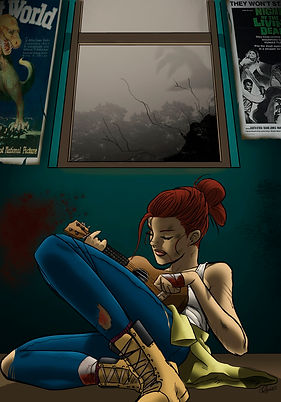

What is the Cimmerian Island
The Cimmerian Island is an asymmetric two player cooperative game involving two players stuck on a mysterious island engulfed in complete darkness. One player is stuck in a bunker and has information about the island and can hack open doors on a tablet, and the ability to light up and view small parts of the island using the Pixelsense. The other player is using a VR-headset and is placed inside the world and need to perform tasks, but can only see the light that the other player illuminates and can communicate via voice.
Trailer

Project Goals
Develop and evaluate a multiplayer immersive experience in mixed reality games using virtual and augmented reality with heads up displays, tabletop interaction, whole-body input, asymmetric game mechanics, and two-way communication. Particular focus will be placed on advanced computer graphics, including modeling and shading, and on advanced interaction, specifically the exploration between the physical and virtual layers of mixed realities.
Intended Learning Outcomes
The ILOs will be shared across the students, meaning not every student necessarily needs to learn all the ILOs, but at least two
Investigate related work in state-of-the-art modeling and rendering, including shaders, lighting, and special effects and implement the most relevant methods from this work.
Design and implement heterogeneous software and hardware architectures that incorporate robust and resilient patterns including inter-process communication and networking such that the project’s prototype is stable enough for user testing.
Utilize User-Centered Design (UCD) methods for the development and evaluation of the project.
Write an academic paper that is of publishable quality (ACM SIGGRAPH).
Present and compete in open student competitions.

Documentation is important. When developing for the Microsoft PixelSense, we noticed that entire ares of the documentation had been removed.
Development take time. In the early stages of the development we had the ambition to create all of the assets ourselves. This turned out to be a daunting task that we simply didn't have the resources for.
The importance of other users testing the game during development. We tested the game ourselves for larger parts of the development. This was a problem because we had to much knowledge about what to do and how you were supposed to solve the problems. This made the game to hard and unclear for users without previous knowledge about the gameplay.
Cooperation and communication within the team is essential for a successful development process. Everyone in the project had different amount of time at their disposal at different times due to other courses. This created clashes between peoples visions for the game and how the development was supposed to be carried out.
User Studies
Investigating the research question will be done through a series of user test sessions. Each session will be recorded through the use of auditory equipment as to collect all interaction and communication performed between the two players.
Before starting the test the players are instructed on how the game is played. Both are given basic control instructions. The VR part of the game takes slightly longer to explain. Only the player at the table is made aware of the goal. He is presented the instructions for the game via a short illustrated guide, marking the positions of the various places of interest. In order for the game to be beaten this player then has to communicate these goals to the VR player. He is not made aware that there are monsters within the game, the VR player discovers that over the course of the game.
Lessons learned

Related Work
Different communication techniques in cooperative multiplayer games has been explored previously [Zach]. A particular sub-group of collaborative communication which our game belongs to is the environment-modifying subgroup. Although the light interaction may not modify an environment, it provides a tool to reveal the surrounding environment for the VR player. In a sense it’s also a type of attention-focusing game mechanic that makes the VR player pay greater attention to an area that is lit up. The interactive way this is being done in our game in combination with VR has to our knowledge never been done previously.
A model for computer-mediated communication (CMC) in multiplayer first-person-shooter games was suggested by Thon [Thon]. This model consists of four different parts that govern the communication in a multiplayer game.
Meet The Team

Gallery



















